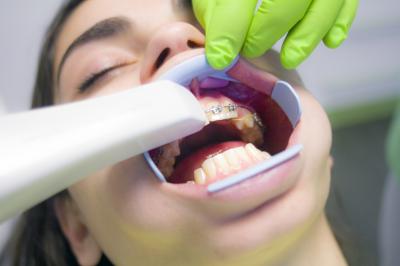Getting braces is a big deal, and choosing what orthodontic option you will go with can be a challenging decision. The most common options are either an Invisalign retainer or traditional braces. Invisalign and other invisible aligners are removable orthodontics, while braces are fixed orthodontics.
Both are meant to correct misaligned and crooked teeth, but do they work the same way?
How does Invisalign work?

Smile Correction: Invisalign can be used to correct minor crowding or impaction, but is not applicable in more severe conditions. Because the aligners are removable and not attached to the teeth, they cannot grip individual teeth, thus making it harder to align. Invisible retainers are a great option for those who have a few crowded teeth or want to tune up their smile. Check out our blog post discussing Minor Tooth Movement (MTM) aligners for more information on minor correction options.
Length of Time: Liners must be worn for 22 hours a day. On average, it takes about 6 months to a year to correct teeth with aligners.
Maintenance: A new aligner will be used every two weeks, and appointments will run every three months.
Cleaning: Fairly easy to clean, aligners require regular soaking to remove bacteria. Don't neglect your oral hygiene routine either— keeping your teeth cleaned and flossed is just as important as cleansing the aligners. You can also whiten your teeth throughout this treatment.
Comfort: Invisible aligners are less uncomfortable than metal braces, and offer less chance for injury through cutting the mouth or lips on the braces. It may be easier for those that may experience interference with work and activities due to mouth pain, such as students who play wind instruments or sports.
Durability: Detachment does put aligners at higher risk of being lost or damaged.
Cost: Invisalign can cost anywhere from $2,000-$9,000, which is a bit more expensive than traditional braces. This is often a better option for adults and working professionals.
A Breakdown on Traditional Orthodontic Braces

Correction: Braces shift your teeth using brackets that are bonded to each tooth and connected by a metal wire. Orthodontists will tighten the wires on an almost monthly basis so that the tension causes the teeth to shift. Brackets can be made of metal or ceramic.
Length of Time: It can take anywhere from 1-3 years to correct teeth, sometimes longer.
Maintenance: Traditional braces require a bit more upkeep: monthly or bi-monthly appointments must be made for adjustments, as well as specialized flossing or cleaning treatments for more severe cases.
Cleaning: Cleaning can be a difficult aspect to manage with traditional braces, but a very important one. Debris can get trapped in the braces, leading to tooth decay or discoloration. It may be best to avoid overly hard or chewy foods, as they are more susceptible to getting stuck in the braces. In addition, brackets can cause damage to the enamel, leaving behind white spots if not cleaned thoroughly enough.
Comfort: Generally, comfort is not a major aspect of braces. All of that precise correction does come with pain in the teeth or gums and possible cuts and bruising to the cheeks in lips, especially when first put on or during adjustments.
Durability: Although wires and rubber bands can snap, you run a much lower risk of damaging or losing your braces.
Cost: Braces can cost anywhere from $1,500-$4,000. Traditional braces are often covered by health insurance for youth, making it a more cost-effective option for families.
Consider Your Options and Consult the Professionals
At Kneib Dentistry, we offer both fixed and removable orthodontic treatments depending on the condition of your teeth, budget, and other considerations. For more information or to set up a consultation, contact us at 814-983-7093 or on our Contact Page.


